Quality Planning and Analysis: Customer Needs and Design Requirements
VerifiedAdded on 2021/06/17
|37
|6994
|219
Report
AI Summary
This report provides a comprehensive quality planning and analysis for LG washing machines. It begins with an introduction to the product and the company, LG Corporation, followed by an analysis of customer satisfaction, exploring stakeholder expectations and various methods for identifying customer needs, including surveys, interviews, and focus groups. The report then delves into design requirements, utilizing QFD and Design Risk Analysis (FMEA) to translate customer needs into design specifications. It covers supplier selection and evaluation, outlining criteria and system construction. Furthermore, the report examines statistical process control (SPC) and problem-solving techniques, including brainstorming and Pareto diagrams. The document provides a detailed analysis of various quality planning aspects, from initial customer need identification to the implementation of statistical process control, offering valuable insights into ensuring product quality and customer satisfaction within the context of LG's washing machine production.
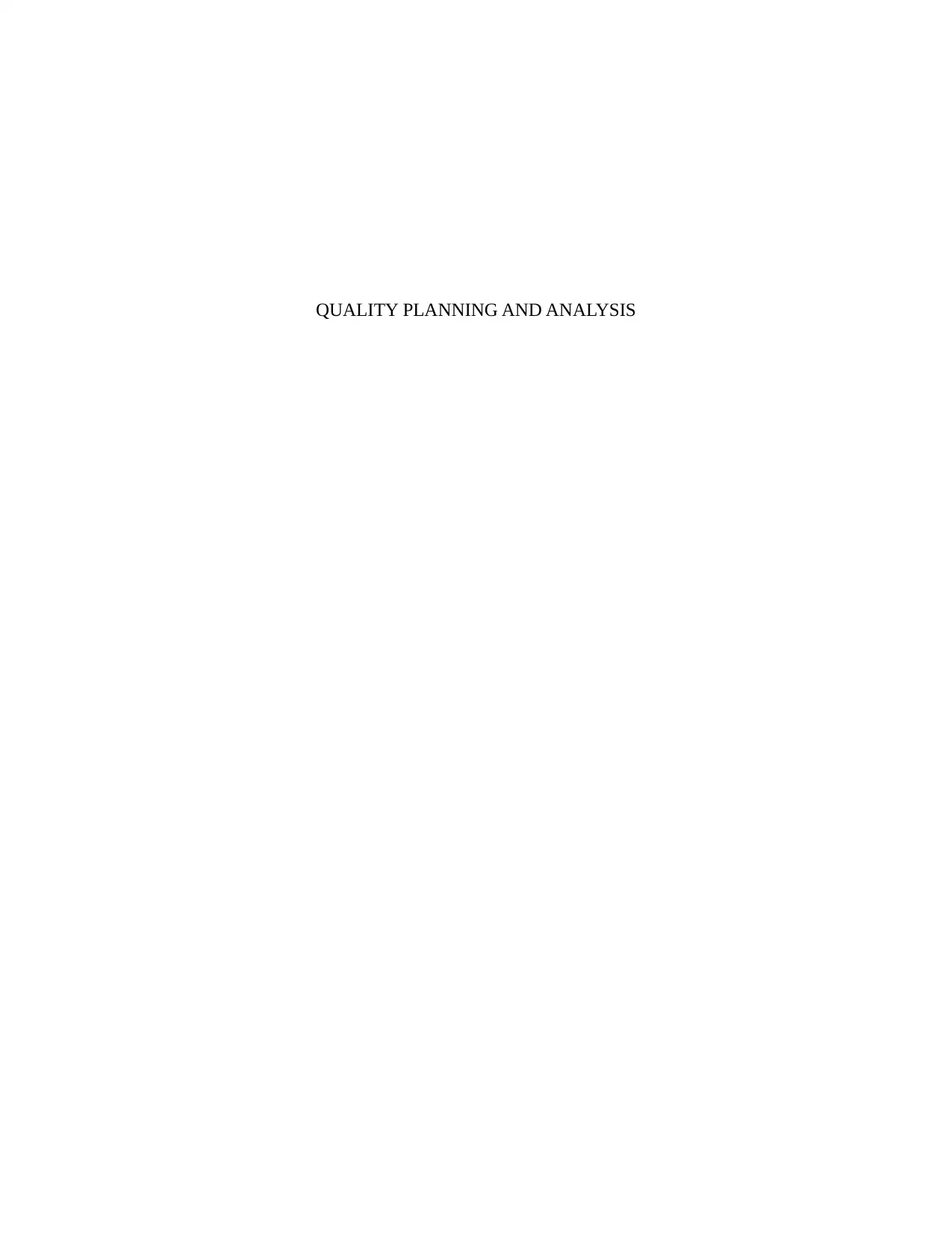
QUALITY PLANNING AND ANALYSIS
Paraphrase This Document
Need a fresh take? Get an instant paraphrase of this document with our AI Paraphraser
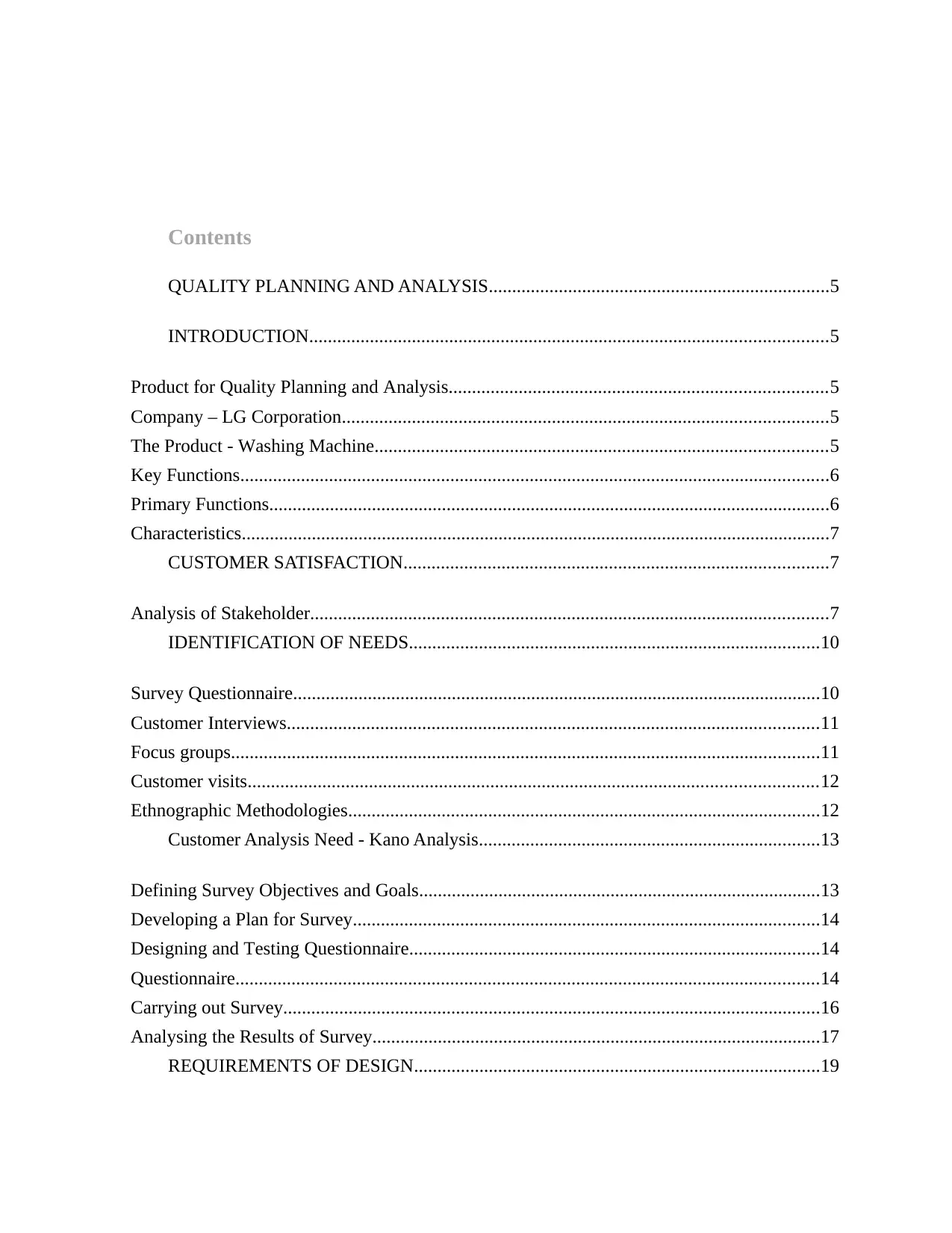
Contents
QUALITY PLANNING AND ANALYSIS.........................................................................5
INTRODUCTION...............................................................................................................5
Product for Quality Planning and Analysis.................................................................................5
Company – LG Corporation........................................................................................................5
The Product - Washing Machine.................................................................................................5
Key Functions..............................................................................................................................6
Primary Functions........................................................................................................................6
Characteristics..............................................................................................................................7
CUSTOMER SATISFACTION...........................................................................................7
Analysis of Stakeholder...............................................................................................................7
IDENTIFICATION OF NEEDS........................................................................................10
Survey Questionnaire.................................................................................................................10
Customer Interviews..................................................................................................................11
Focus groups..............................................................................................................................11
Customer visits..........................................................................................................................12
Ethnographic Methodologies.....................................................................................................12
Customer Analysis Need - Kano Analysis.........................................................................13
Defining Survey Objectives and Goals......................................................................................13
Developing a Plan for Survey....................................................................................................14
Designing and Testing Questionnaire........................................................................................14
Questionnaire.............................................................................................................................14
Carrying out Survey...................................................................................................................16
Analysing the Results of Survey................................................................................................17
REQUIREMENTS OF DESIGN.......................................................................................19
QUALITY PLANNING AND ANALYSIS.........................................................................5
INTRODUCTION...............................................................................................................5
Product for Quality Planning and Analysis.................................................................................5
Company – LG Corporation........................................................................................................5
The Product - Washing Machine.................................................................................................5
Key Functions..............................................................................................................................6
Primary Functions........................................................................................................................6
Characteristics..............................................................................................................................7
CUSTOMER SATISFACTION...........................................................................................7
Analysis of Stakeholder...............................................................................................................7
IDENTIFICATION OF NEEDS........................................................................................10
Survey Questionnaire.................................................................................................................10
Customer Interviews..................................................................................................................11
Focus groups..............................................................................................................................11
Customer visits..........................................................................................................................12
Ethnographic Methodologies.....................................................................................................12
Customer Analysis Need - Kano Analysis.........................................................................13
Defining Survey Objectives and Goals......................................................................................13
Developing a Plan for Survey....................................................................................................14
Designing and Testing Questionnaire........................................................................................14
Questionnaire.............................................................................................................................14
Carrying out Survey...................................................................................................................16
Analysing the Results of Survey................................................................................................17
REQUIREMENTS OF DESIGN.......................................................................................19
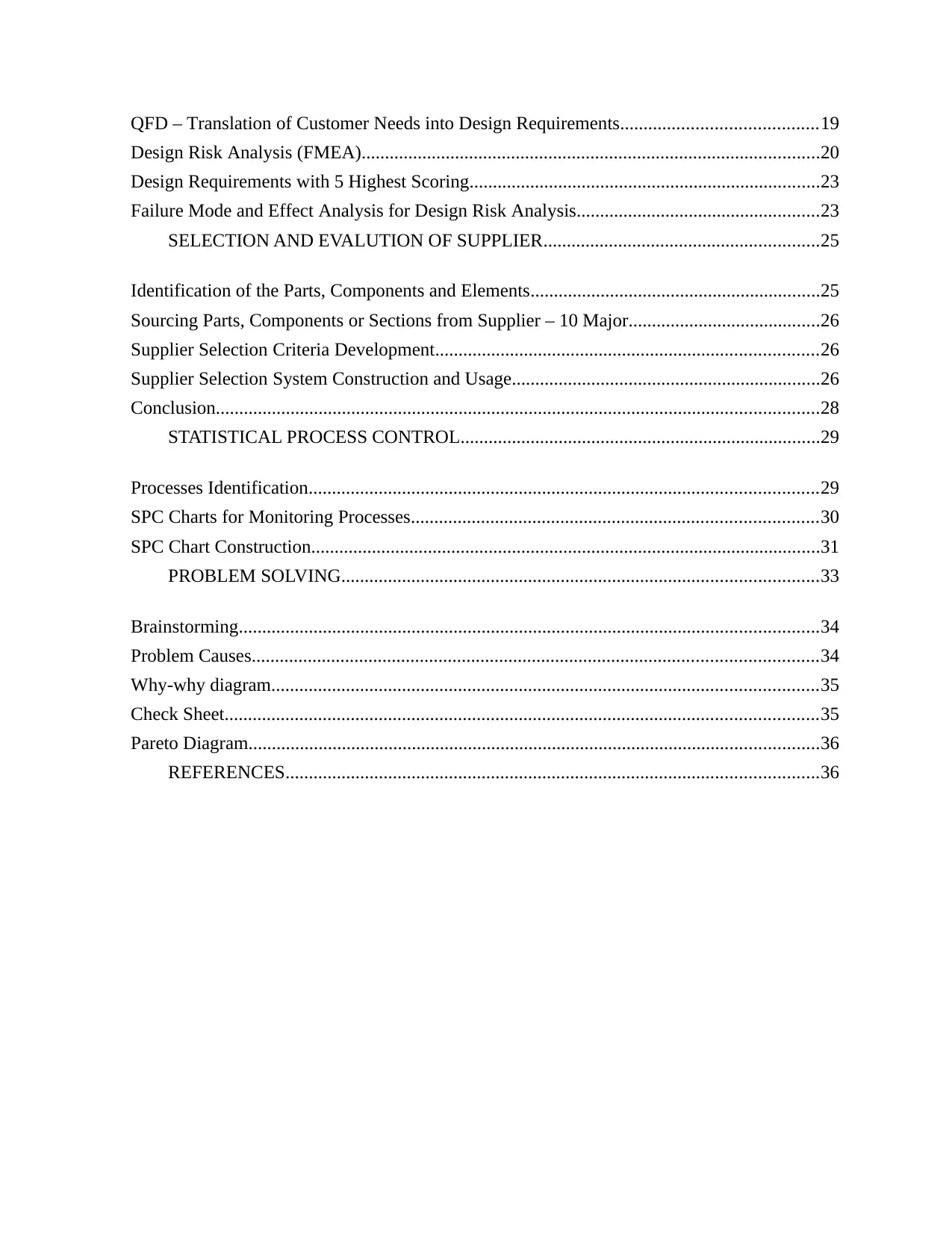
QFD – Translation of Customer Needs into Design Requirements..........................................19
Design Risk Analysis (FMEA)..................................................................................................20
Design Requirements with 5 Highest Scoring...........................................................................23
Failure Mode and Effect Analysis for Design Risk Analysis....................................................23
SELECTION AND EVALUTION OF SUPPLIER...........................................................25
Identification of the Parts, Components and Elements..............................................................25
Sourcing Parts, Components or Sections from Supplier – 10 Major.........................................26
Supplier Selection Criteria Development..................................................................................26
Supplier Selection System Construction and Usage..................................................................26
Conclusion.................................................................................................................................28
STATISTICAL PROCESS CONTROL.............................................................................29
Processes Identification.............................................................................................................29
SPC Charts for Monitoring Processes.......................................................................................30
SPC Chart Construction.............................................................................................................31
PROBLEM SOLVING......................................................................................................33
Brainstorming............................................................................................................................34
Problem Causes.........................................................................................................................34
Why-why diagram.....................................................................................................................35
Check Sheet...............................................................................................................................35
Pareto Diagram..........................................................................................................................36
REFERENCES..................................................................................................................36
Design Risk Analysis (FMEA)..................................................................................................20
Design Requirements with 5 Highest Scoring...........................................................................23
Failure Mode and Effect Analysis for Design Risk Analysis....................................................23
SELECTION AND EVALUTION OF SUPPLIER...........................................................25
Identification of the Parts, Components and Elements..............................................................25
Sourcing Parts, Components or Sections from Supplier – 10 Major.........................................26
Supplier Selection Criteria Development..................................................................................26
Supplier Selection System Construction and Usage..................................................................26
Conclusion.................................................................................................................................28
STATISTICAL PROCESS CONTROL.............................................................................29
Processes Identification.............................................................................................................29
SPC Charts for Monitoring Processes.......................................................................................30
SPC Chart Construction.............................................................................................................31
PROBLEM SOLVING......................................................................................................33
Brainstorming............................................................................................................................34
Problem Causes.........................................................................................................................34
Why-why diagram.....................................................................................................................35
Check Sheet...............................................................................................................................35
Pareto Diagram..........................................................................................................................36
REFERENCES..................................................................................................................36
⊘ This is a preview!⊘
Do you want full access?
Subscribe today to unlock all pages.

Trusted by 1+ million students worldwide
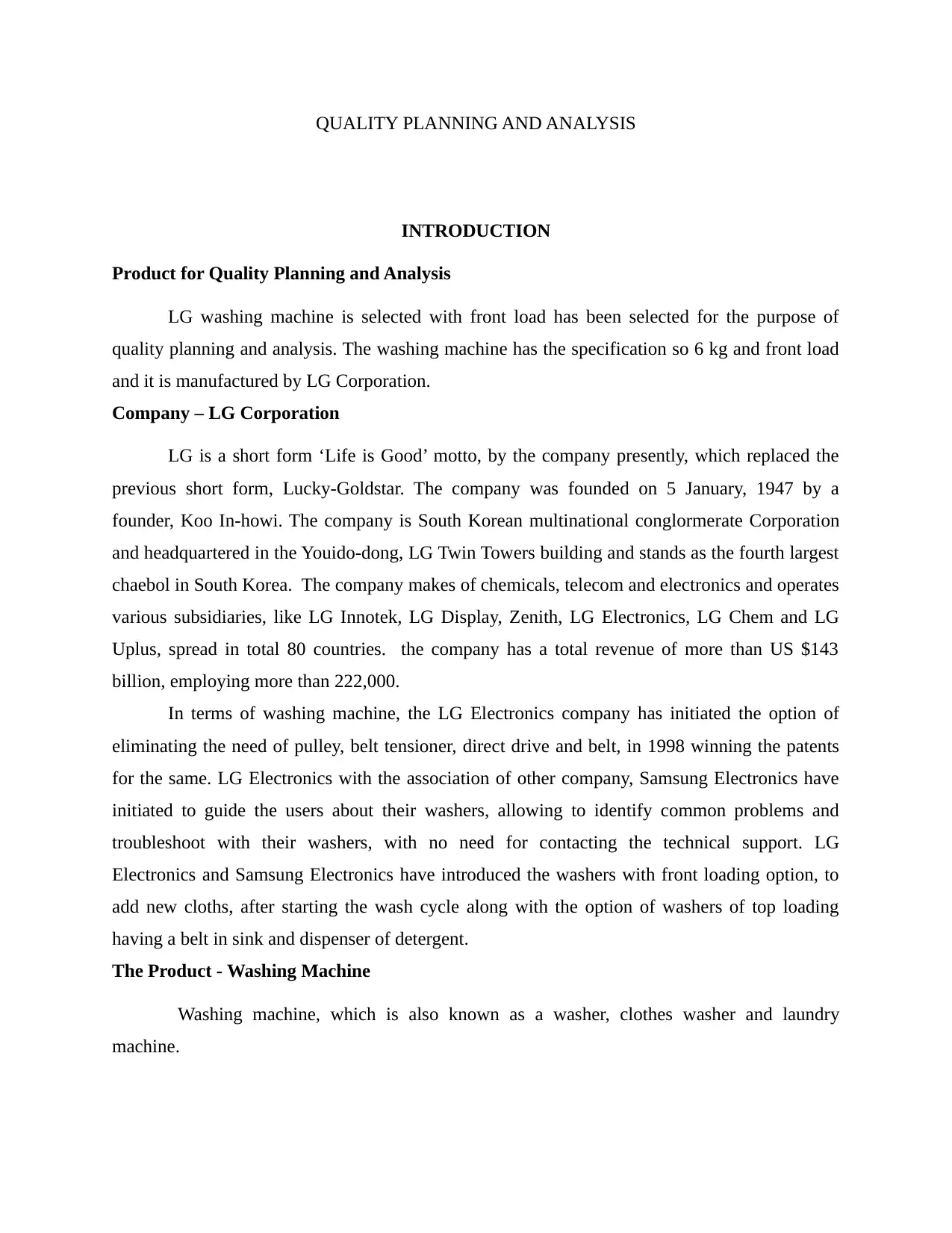
QUALITY PLANNING AND ANALYSIS
INTRODUCTION
Product for Quality Planning and Analysis
LG washing machine is selected with front load has been selected for the purpose of
quality planning and analysis. The washing machine has the specification so 6 kg and front load
and it is manufactured by LG Corporation.
Company – LG Corporation
LG is a short form ‘Life is Good’ motto, by the company presently, which replaced the
previous short form, Lucky-Goldstar. The company was founded on 5 January, 1947 by a
founder, Koo In-howi. The company is South Korean multinational conglormerate Corporation
and headquartered in the Youido-dong, LG Twin Towers building and stands as the fourth largest
chaebol in South Korea. The company makes of chemicals, telecom and electronics and operates
various subsidiaries, like LG Innotek, LG Display, Zenith, LG Electronics, LG Chem and LG
Uplus, spread in total 80 countries. the company has a total revenue of more than US $143
billion, employing more than 222,000.
In terms of washing machine, the LG Electronics company has initiated the option of
eliminating the need of pulley, belt tensioner, direct drive and belt, in 1998 winning the patents
for the same. LG Electronics with the association of other company, Samsung Electronics have
initiated to guide the users about their washers, allowing to identify common problems and
troubleshoot with their washers, with no need for contacting the technical support. LG
Electronics and Samsung Electronics have introduced the washers with front loading option, to
add new cloths, after starting the wash cycle along with the option of washers of top loading
having a belt in sink and dispenser of detergent.
The Product - Washing Machine
Washing machine, which is also known as a washer, clothes washer and laundry
machine.
INTRODUCTION
Product for Quality Planning and Analysis
LG washing machine is selected with front load has been selected for the purpose of
quality planning and analysis. The washing machine has the specification so 6 kg and front load
and it is manufactured by LG Corporation.
Company – LG Corporation
LG is a short form ‘Life is Good’ motto, by the company presently, which replaced the
previous short form, Lucky-Goldstar. The company was founded on 5 January, 1947 by a
founder, Koo In-howi. The company is South Korean multinational conglormerate Corporation
and headquartered in the Youido-dong, LG Twin Towers building and stands as the fourth largest
chaebol in South Korea. The company makes of chemicals, telecom and electronics and operates
various subsidiaries, like LG Innotek, LG Display, Zenith, LG Electronics, LG Chem and LG
Uplus, spread in total 80 countries. the company has a total revenue of more than US $143
billion, employing more than 222,000.
In terms of washing machine, the LG Electronics company has initiated the option of
eliminating the need of pulley, belt tensioner, direct drive and belt, in 1998 winning the patents
for the same. LG Electronics with the association of other company, Samsung Electronics have
initiated to guide the users about their washers, allowing to identify common problems and
troubleshoot with their washers, with no need for contacting the technical support. LG
Electronics and Samsung Electronics have introduced the washers with front loading option, to
add new cloths, after starting the wash cycle along with the option of washers of top loading
having a belt in sink and dispenser of detergent.
The Product - Washing Machine
Washing machine, which is also known as a washer, clothes washer and laundry
machine.
Paraphrase This Document
Need a fresh take? Get an instant paraphrase of this document with our AI Paraphraser
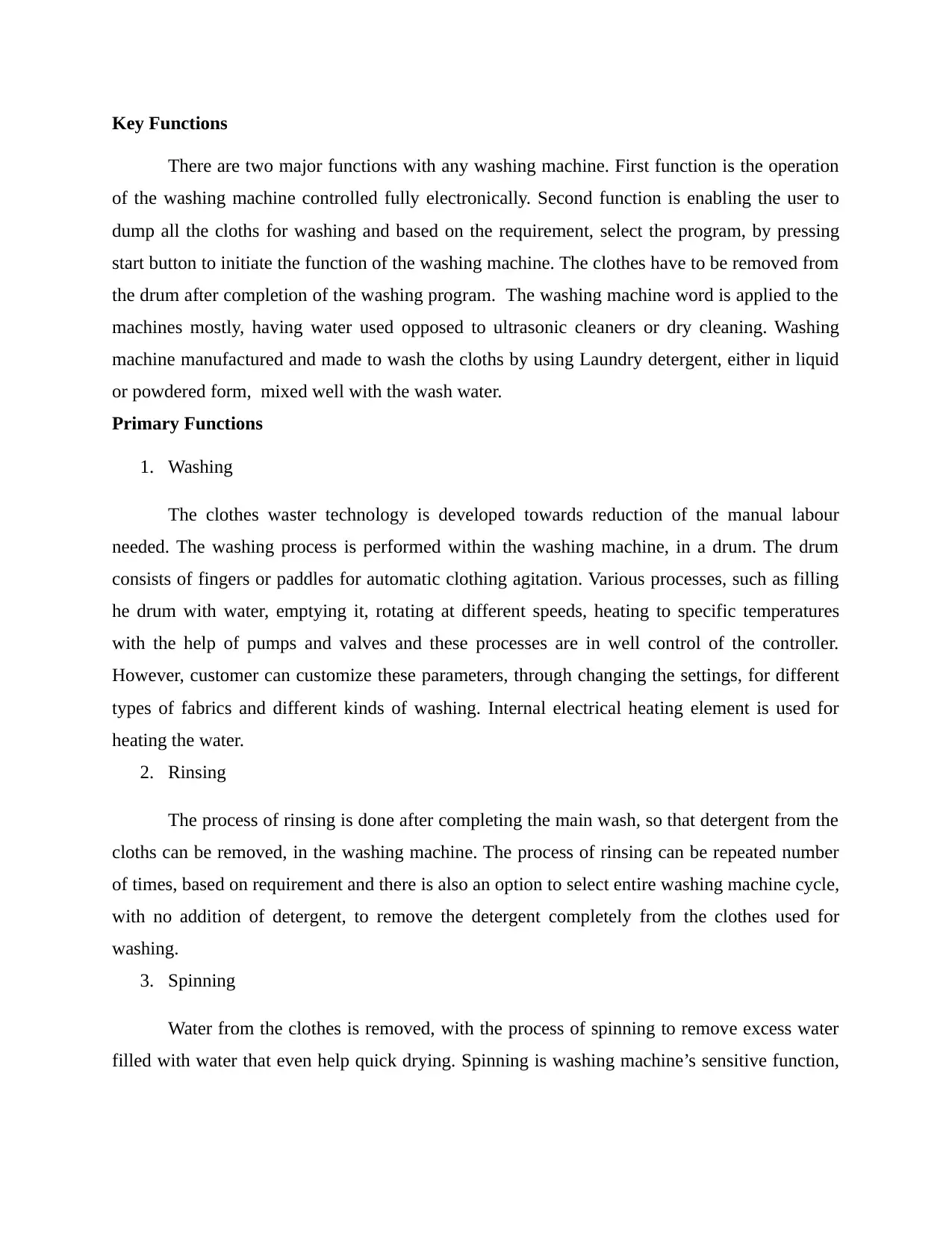
Key Functions
There are two major functions with any washing machine. First function is the operation
of the washing machine controlled fully electronically. Second function is enabling the user to
dump all the cloths for washing and based on the requirement, select the program, by pressing
start button to initiate the function of the washing machine. The clothes have to be removed from
the drum after completion of the washing program. The washing machine word is applied to the
machines mostly, having water used opposed to ultrasonic cleaners or dry cleaning. Washing
machine manufactured and made to wash the cloths by using Laundry detergent, either in liquid
or powdered form, mixed well with the wash water.
Primary Functions
1. Washing
The clothes waster technology is developed towards reduction of the manual labour
needed. The washing process is performed within the washing machine, in a drum. The drum
consists of fingers or paddles for automatic clothing agitation. Various processes, such as filling
he drum with water, emptying it, rotating at different speeds, heating to specific temperatures
with the help of pumps and valves and these processes are in well control of the controller.
However, customer can customize these parameters, through changing the settings, for different
types of fabrics and different kinds of washing. Internal electrical heating element is used for
heating the water.
2. Rinsing
The process of rinsing is done after completing the main wash, so that detergent from the
cloths can be removed, in the washing machine. The process of rinsing can be repeated number
of times, based on requirement and there is also an option to select entire washing machine cycle,
with no addition of detergent, to remove the detergent completely from the clothes used for
washing.
3. Spinning
Water from the clothes is removed, with the process of spinning to remove excess water
filled with water that even help quick drying. Spinning is washing machine’s sensitive function,
There are two major functions with any washing machine. First function is the operation
of the washing machine controlled fully electronically. Second function is enabling the user to
dump all the cloths for washing and based on the requirement, select the program, by pressing
start button to initiate the function of the washing machine. The clothes have to be removed from
the drum after completion of the washing program. The washing machine word is applied to the
machines mostly, having water used opposed to ultrasonic cleaners or dry cleaning. Washing
machine manufactured and made to wash the cloths by using Laundry detergent, either in liquid
or powdered form, mixed well with the wash water.
Primary Functions
1. Washing
The clothes waster technology is developed towards reduction of the manual labour
needed. The washing process is performed within the washing machine, in a drum. The drum
consists of fingers or paddles for automatic clothing agitation. Various processes, such as filling
he drum with water, emptying it, rotating at different speeds, heating to specific temperatures
with the help of pumps and valves and these processes are in well control of the controller.
However, customer can customize these parameters, through changing the settings, for different
types of fabrics and different kinds of washing. Internal electrical heating element is used for
heating the water.
2. Rinsing
The process of rinsing is done after completing the main wash, so that detergent from the
cloths can be removed, in the washing machine. The process of rinsing can be repeated number
of times, based on requirement and there is also an option to select entire washing machine cycle,
with no addition of detergent, to remove the detergent completely from the clothes used for
washing.
3. Spinning
Water from the clothes is removed, with the process of spinning to remove excess water
filled with water that even help quick drying. Spinning is washing machine’s sensitive function,
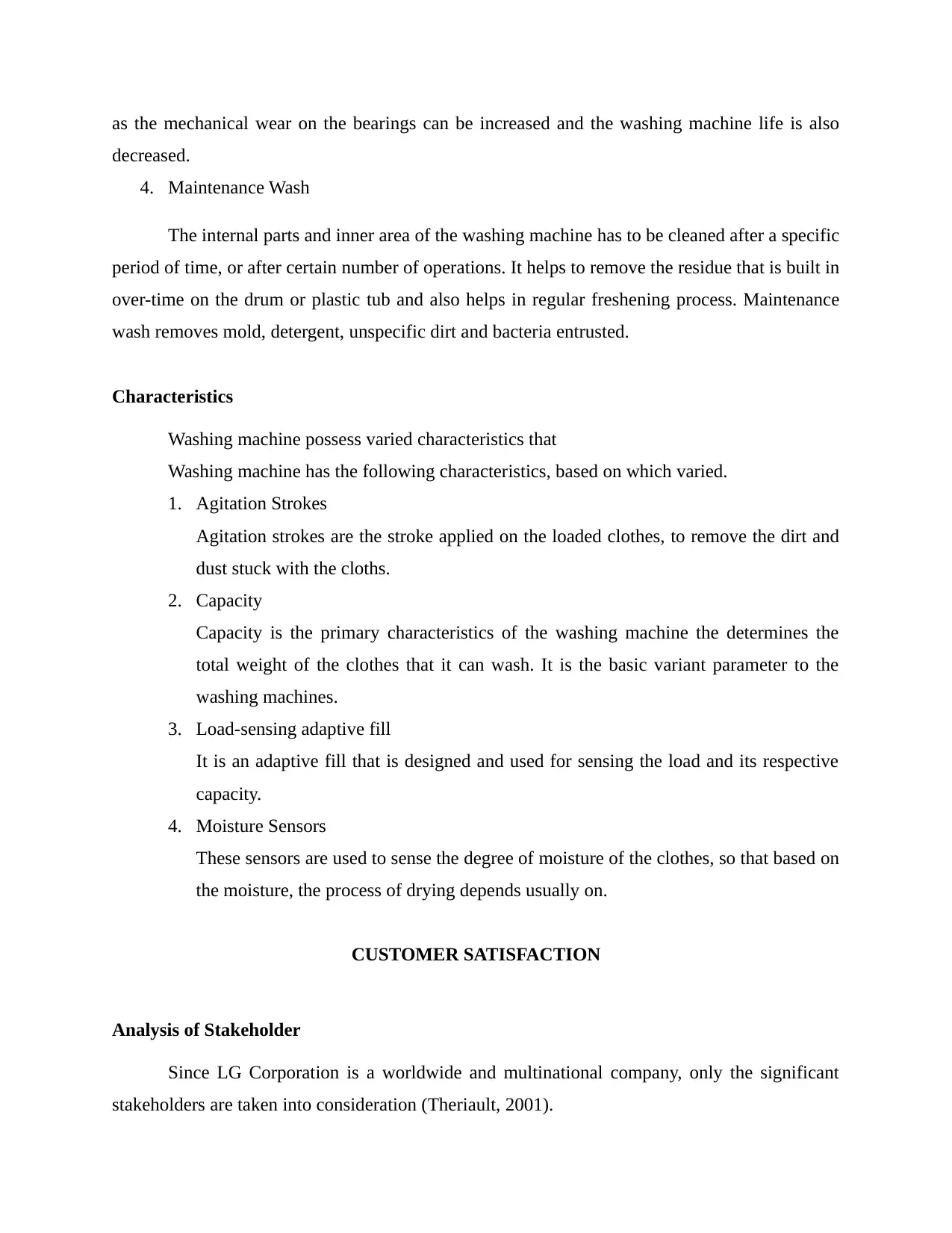
as the mechanical wear on the bearings can be increased and the washing machine life is also
decreased.
4. Maintenance Wash
The internal parts and inner area of the washing machine has to be cleaned after a specific
period of time, or after certain number of operations. It helps to remove the residue that is built in
over-time on the drum or plastic tub and also helps in regular freshening process. Maintenance
wash removes mold, detergent, unspecific dirt and bacteria entrusted.
Characteristics
Washing machine possess varied characteristics that
Washing machine has the following characteristics, based on which varied.
1. Agitation Strokes
Agitation strokes are the stroke applied on the loaded clothes, to remove the dirt and
dust stuck with the cloths.
2. Capacity
Capacity is the primary characteristics of the washing machine the determines the
total weight of the clothes that it can wash. It is the basic variant parameter to the
washing machines.
3. Load-sensing adaptive fill
It is an adaptive fill that is designed and used for sensing the load and its respective
capacity.
4. Moisture Sensors
These sensors are used to sense the degree of moisture of the clothes, so that based on
the moisture, the process of drying depends usually on.
CUSTOMER SATISFACTION
Analysis of Stakeholder
Since LG Corporation is a worldwide and multinational company, only the significant
stakeholders are taken into consideration (Theriault, 2001).
decreased.
4. Maintenance Wash
The internal parts and inner area of the washing machine has to be cleaned after a specific
period of time, or after certain number of operations. It helps to remove the residue that is built in
over-time on the drum or plastic tub and also helps in regular freshening process. Maintenance
wash removes mold, detergent, unspecific dirt and bacteria entrusted.
Characteristics
Washing machine possess varied characteristics that
Washing machine has the following characteristics, based on which varied.
1. Agitation Strokes
Agitation strokes are the stroke applied on the loaded clothes, to remove the dirt and
dust stuck with the cloths.
2. Capacity
Capacity is the primary characteristics of the washing machine the determines the
total weight of the clothes that it can wash. It is the basic variant parameter to the
washing machines.
3. Load-sensing adaptive fill
It is an adaptive fill that is designed and used for sensing the load and its respective
capacity.
4. Moisture Sensors
These sensors are used to sense the degree of moisture of the clothes, so that based on
the moisture, the process of drying depends usually on.
CUSTOMER SATISFACTION
Analysis of Stakeholder
Since LG Corporation is a worldwide and multinational company, only the significant
stakeholders are taken into consideration (Theriault, 2001).
⊘ This is a preview!⊘
Do you want full access?
Subscribe today to unlock all pages.

Trusted by 1+ million students worldwide
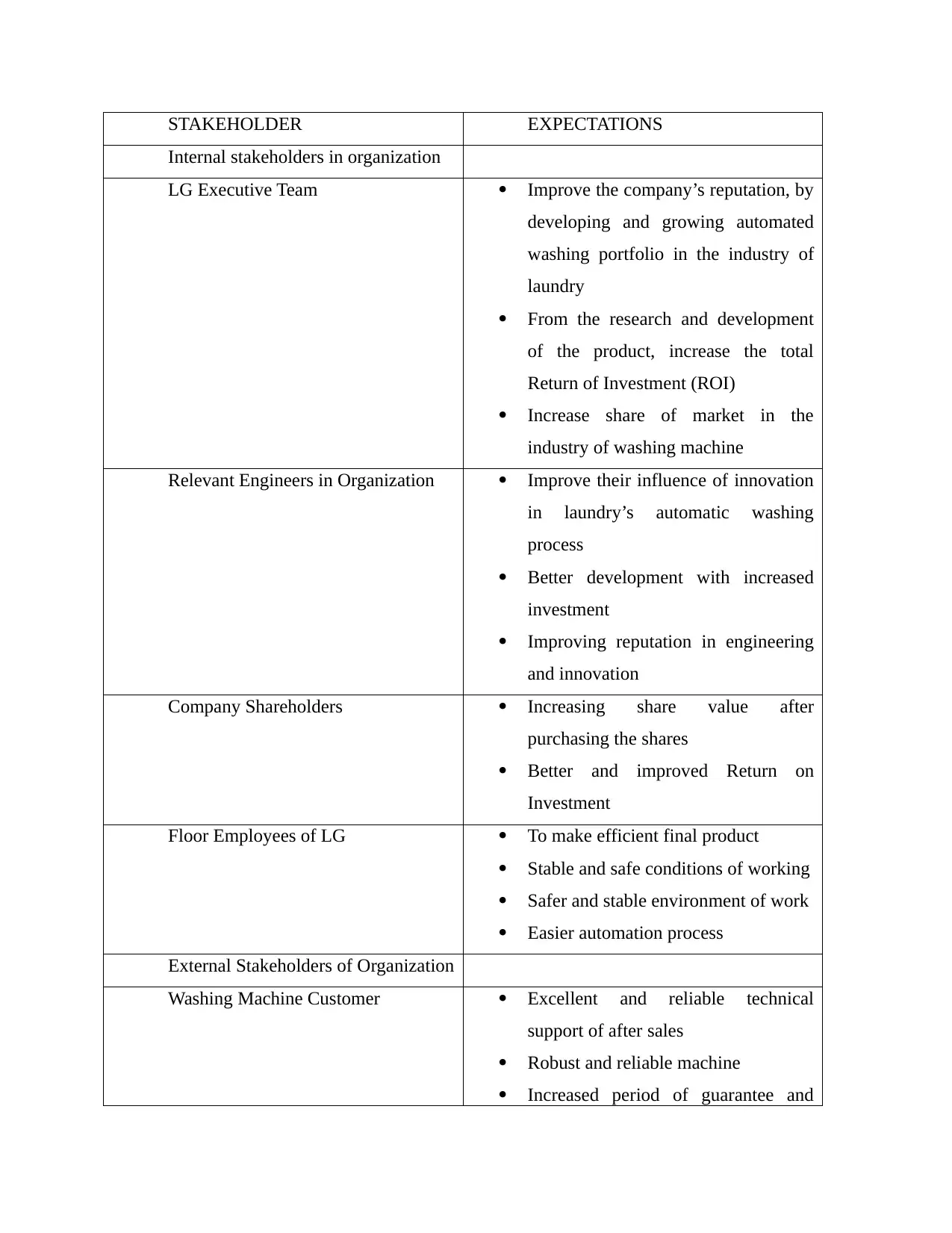
STAKEHOLDER EXPECTATIONS
Internal stakeholders in organization
LG Executive Team Improve the company’s reputation, by
developing and growing automated
washing portfolio in the industry of
laundry
From the research and development
of the product, increase the total
Return of Investment (ROI)
Increase share of market in the
industry of washing machine
Relevant Engineers in Organization Improve their influence of innovation
in laundry’s automatic washing
process
Better development with increased
investment
Improving reputation in engineering
and innovation
Company Shareholders Increasing share value after
purchasing the shares
Better and improved Return on
Investment
Floor Employees of LG To make efficient final product
Stable and safe conditions of working
Safer and stable environment of work
Easier automation process
External Stakeholders of Organization
Washing Machine Customer Excellent and reliable technical
support of after sales
Robust and reliable machine
Increased period of guarantee and
Internal stakeholders in organization
LG Executive Team Improve the company’s reputation, by
developing and growing automated
washing portfolio in the industry of
laundry
From the research and development
of the product, increase the total
Return of Investment (ROI)
Increase share of market in the
industry of washing machine
Relevant Engineers in Organization Improve their influence of innovation
in laundry’s automatic washing
process
Better development with increased
investment
Improving reputation in engineering
and innovation
Company Shareholders Increasing share value after
purchasing the shares
Better and improved Return on
Investment
Floor Employees of LG To make efficient final product
Stable and safe conditions of working
Safer and stable environment of work
Easier automation process
External Stakeholders of Organization
Washing Machine Customer Excellent and reliable technical
support of after sales
Robust and reliable machine
Increased period of guarantee and
Paraphrase This Document
Need a fresh take? Get an instant paraphrase of this document with our AI Paraphraser
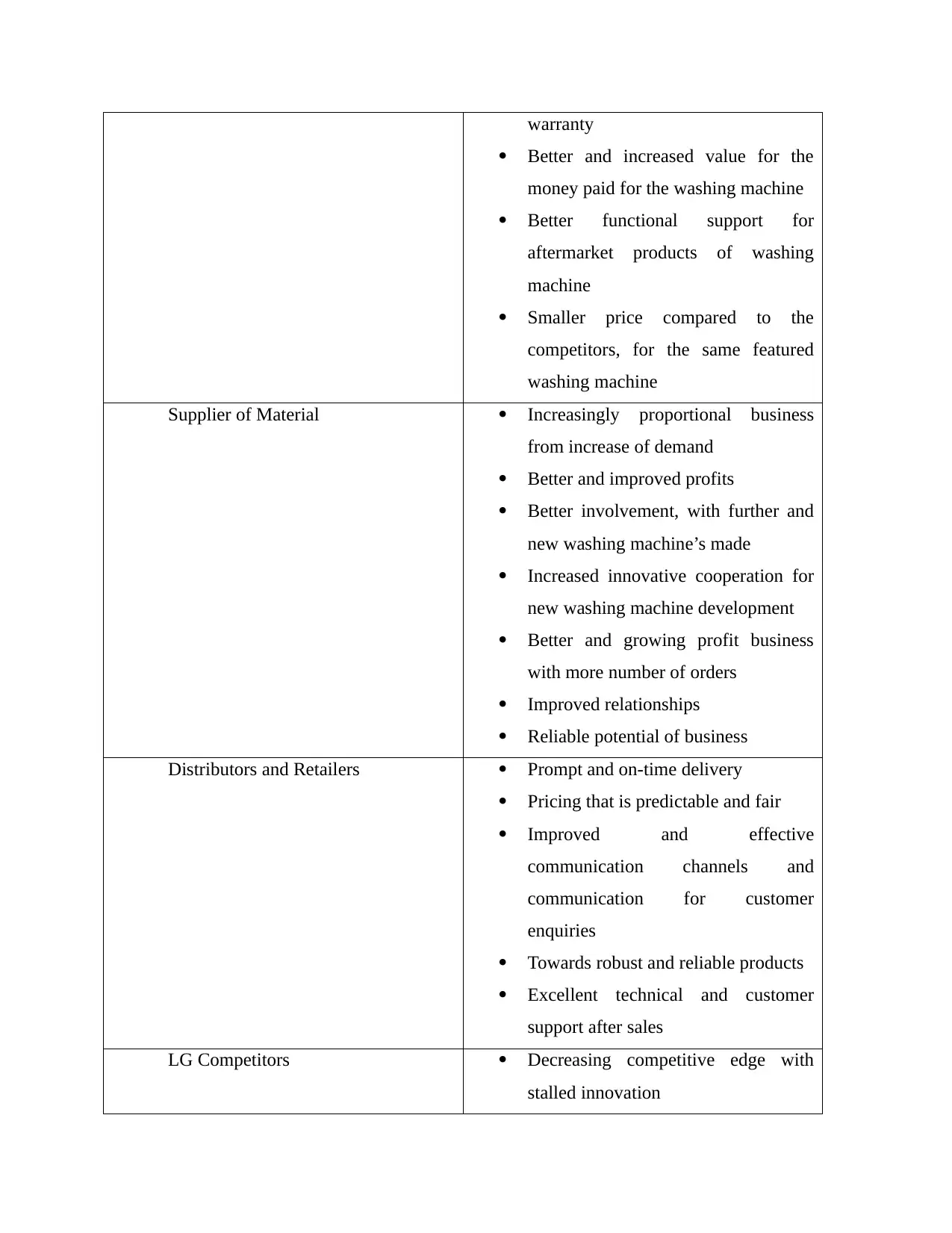
warranty
Better and increased value for the
money paid for the washing machine
Better functional support for
aftermarket products of washing
machine
Smaller price compared to the
competitors, for the same featured
washing machine
Supplier of Material Increasingly proportional business
from increase of demand
Better and improved profits
Better involvement, with further and
new washing machine’s made
Increased innovative cooperation for
new washing machine development
Better and growing profit business
with more number of orders
Improved relationships
Reliable potential of business
Distributors and Retailers Prompt and on-time delivery
Pricing that is predictable and fair
Improved and effective
communication channels and
communication for customer
enquiries
Towards robust and reliable products
Excellent technical and customer
support after sales
LG Competitors Decreasing competitive edge with
stalled innovation
Better and increased value for the
money paid for the washing machine
Better functional support for
aftermarket products of washing
machine
Smaller price compared to the
competitors, for the same featured
washing machine
Supplier of Material Increasingly proportional business
from increase of demand
Better and improved profits
Better involvement, with further and
new washing machine’s made
Increased innovative cooperation for
new washing machine development
Better and growing profit business
with more number of orders
Improved relationships
Reliable potential of business
Distributors and Retailers Prompt and on-time delivery
Pricing that is predictable and fair
Improved and effective
communication channels and
communication for customer
enquiries
Towards robust and reliable products
Excellent technical and customer
support after sales
LG Competitors Decreasing competitive edge with
stalled innovation
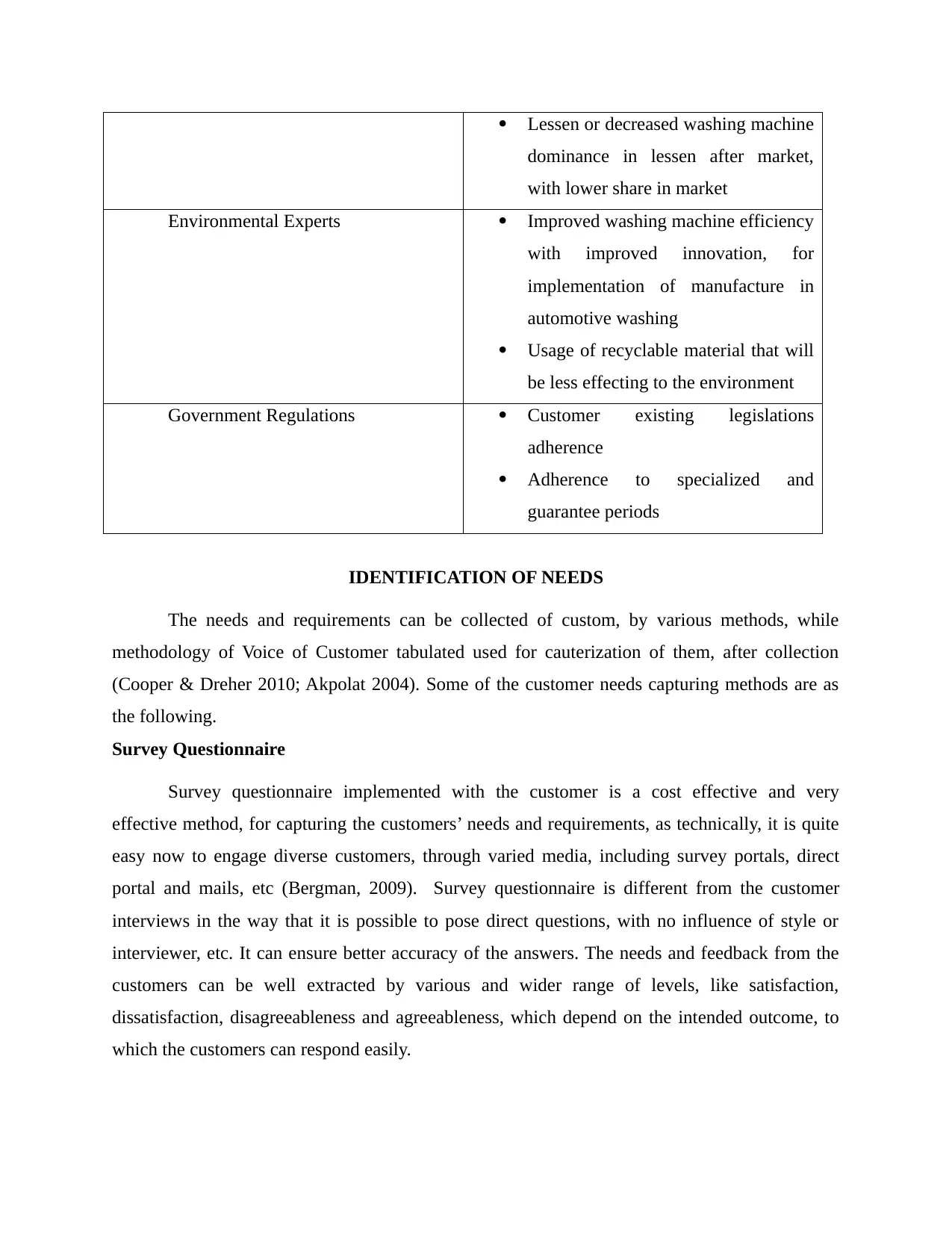
Lessen or decreased washing machine
dominance in lessen after market,
with lower share in market
Environmental Experts Improved washing machine efficiency
with improved innovation, for
implementation of manufacture in
automotive washing
Usage of recyclable material that will
be less effecting to the environment
Government Regulations Customer existing legislations
adherence
Adherence to specialized and
guarantee periods
IDENTIFICATION OF NEEDS
The needs and requirements can be collected of custom, by various methods, while
methodology of Voice of Customer tabulated used for cauterization of them, after collection
(Cooper & Dreher 2010; Akpolat 2004). Some of the customer needs capturing methods are as
the following.
Survey Questionnaire
Survey questionnaire implemented with the customer is a cost effective and very
effective method, for capturing the customers’ needs and requirements, as technically, it is quite
easy now to engage diverse customers, through varied media, including survey portals, direct
portal and mails, etc (Bergman, 2009). Survey questionnaire is different from the customer
interviews in the way that it is possible to pose direct questions, with no influence of style or
interviewer, etc. It can ensure better accuracy of the answers. The needs and feedback from the
customers can be well extracted by various and wider range of levels, like satisfaction,
dissatisfaction, disagreeableness and agreeableness, which depend on the intended outcome, to
which the customers can respond easily.
dominance in lessen after market,
with lower share in market
Environmental Experts Improved washing machine efficiency
with improved innovation, for
implementation of manufacture in
automotive washing
Usage of recyclable material that will
be less effecting to the environment
Government Regulations Customer existing legislations
adherence
Adherence to specialized and
guarantee periods
IDENTIFICATION OF NEEDS
The needs and requirements can be collected of custom, by various methods, while
methodology of Voice of Customer tabulated used for cauterization of them, after collection
(Cooper & Dreher 2010; Akpolat 2004). Some of the customer needs capturing methods are as
the following.
Survey Questionnaire
Survey questionnaire implemented with the customer is a cost effective and very
effective method, for capturing the customers’ needs and requirements, as technically, it is quite
easy now to engage diverse customers, through varied media, including survey portals, direct
portal and mails, etc (Bergman, 2009). Survey questionnaire is different from the customer
interviews in the way that it is possible to pose direct questions, with no influence of style or
interviewer, etc. It can ensure better accuracy of the answers. The needs and feedback from the
customers can be well extracted by various and wider range of levels, like satisfaction,
dissatisfaction, disagreeableness and agreeableness, which depend on the intended outcome, to
which the customers can respond easily.
⊘ This is a preview!⊘
Do you want full access?
Subscribe today to unlock all pages.

Trusted by 1+ million students worldwide
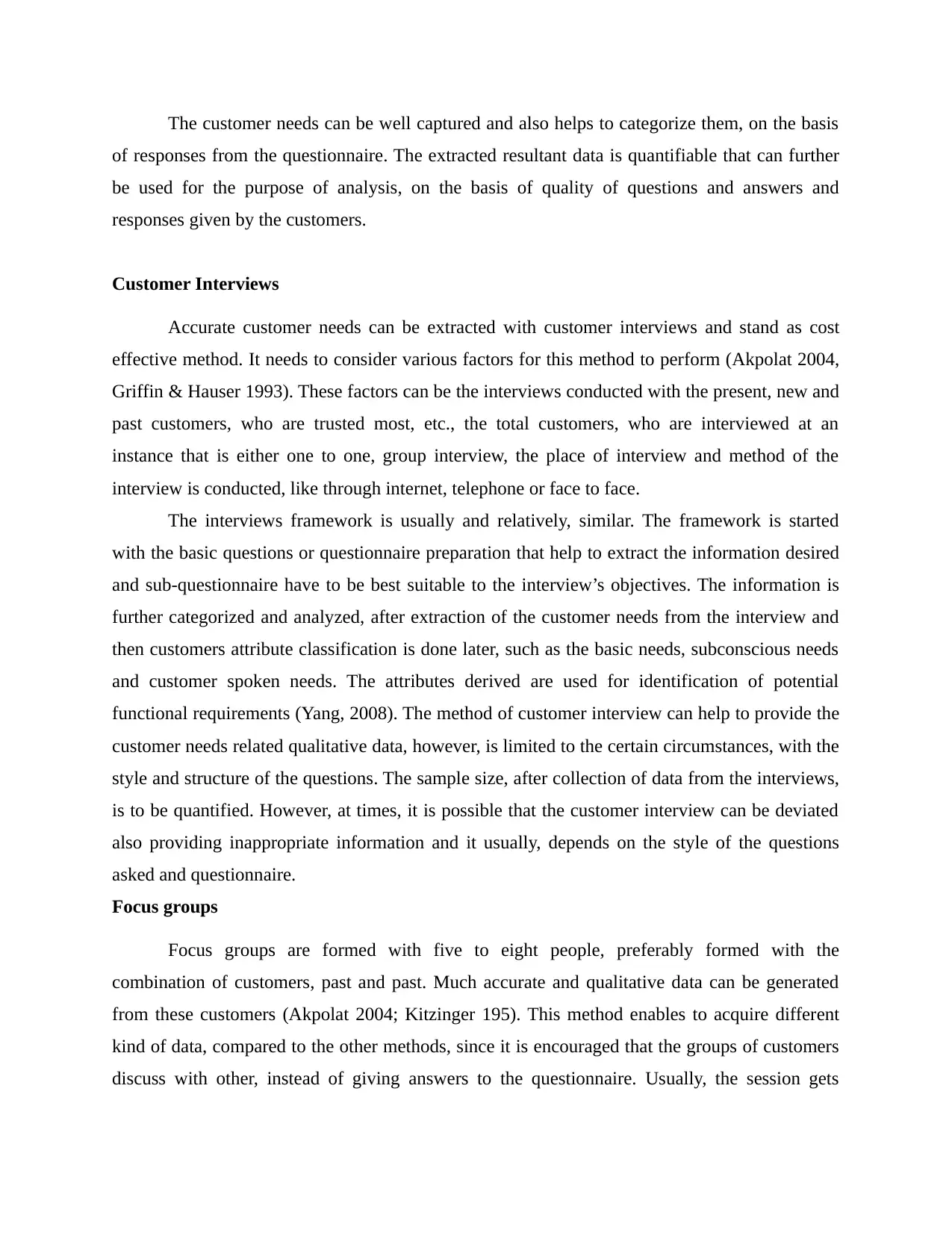
The customer needs can be well captured and also helps to categorize them, on the basis
of responses from the questionnaire. The extracted resultant data is quantifiable that can further
be used for the purpose of analysis, on the basis of quality of questions and answers and
responses given by the customers.
Customer Interviews
Accurate customer needs can be extracted with customer interviews and stand as cost
effective method. It needs to consider various factors for this method to perform (Akpolat 2004,
Griffin & Hauser 1993). These factors can be the interviews conducted with the present, new and
past customers, who are trusted most, etc., the total customers, who are interviewed at an
instance that is either one to one, group interview, the place of interview and method of the
interview is conducted, like through internet, telephone or face to face.
The interviews framework is usually and relatively, similar. The framework is started
with the basic questions or questionnaire preparation that help to extract the information desired
and sub-questionnaire have to be best suitable to the interview’s objectives. The information is
further categorized and analyzed, after extraction of the customer needs from the interview and
then customers attribute classification is done later, such as the basic needs, subconscious needs
and customer spoken needs. The attributes derived are used for identification of potential
functional requirements (Yang, 2008). The method of customer interview can help to provide the
customer needs related qualitative data, however, is limited to the certain circumstances, with the
style and structure of the questions. The sample size, after collection of data from the interviews,
is to be quantified. However, at times, it is possible that the customer interview can be deviated
also providing inappropriate information and it usually, depends on the style of the questions
asked and questionnaire.
Focus groups
Focus groups are formed with five to eight people, preferably formed with the
combination of customers, past and past. Much accurate and qualitative data can be generated
from these customers (Akpolat 2004; Kitzinger 195). This method enables to acquire different
kind of data, compared to the other methods, since it is encouraged that the groups of customers
discuss with other, instead of giving answers to the questionnaire. Usually, the session gets
of responses from the questionnaire. The extracted resultant data is quantifiable that can further
be used for the purpose of analysis, on the basis of quality of questions and answers and
responses given by the customers.
Customer Interviews
Accurate customer needs can be extracted with customer interviews and stand as cost
effective method. It needs to consider various factors for this method to perform (Akpolat 2004,
Griffin & Hauser 1993). These factors can be the interviews conducted with the present, new and
past customers, who are trusted most, etc., the total customers, who are interviewed at an
instance that is either one to one, group interview, the place of interview and method of the
interview is conducted, like through internet, telephone or face to face.
The interviews framework is usually and relatively, similar. The framework is started
with the basic questions or questionnaire preparation that help to extract the information desired
and sub-questionnaire have to be best suitable to the interview’s objectives. The information is
further categorized and analyzed, after extraction of the customer needs from the interview and
then customers attribute classification is done later, such as the basic needs, subconscious needs
and customer spoken needs. The attributes derived are used for identification of potential
functional requirements (Yang, 2008). The method of customer interview can help to provide the
customer needs related qualitative data, however, is limited to the certain circumstances, with the
style and structure of the questions. The sample size, after collection of data from the interviews,
is to be quantified. However, at times, it is possible that the customer interview can be deviated
also providing inappropriate information and it usually, depends on the style of the questions
asked and questionnaire.
Focus groups
Focus groups are formed with five to eight people, preferably formed with the
combination of customers, past and past. Much accurate and qualitative data can be generated
from these customers (Akpolat 2004; Kitzinger 195). This method enables to acquire different
kind of data, compared to the other methods, since it is encouraged that the groups of customers
discuss with other, instead of giving answers to the questionnaire. Usually, the session gets
Paraphrase This Document
Need a fresh take? Get an instant paraphrase of this document with our AI Paraphraser
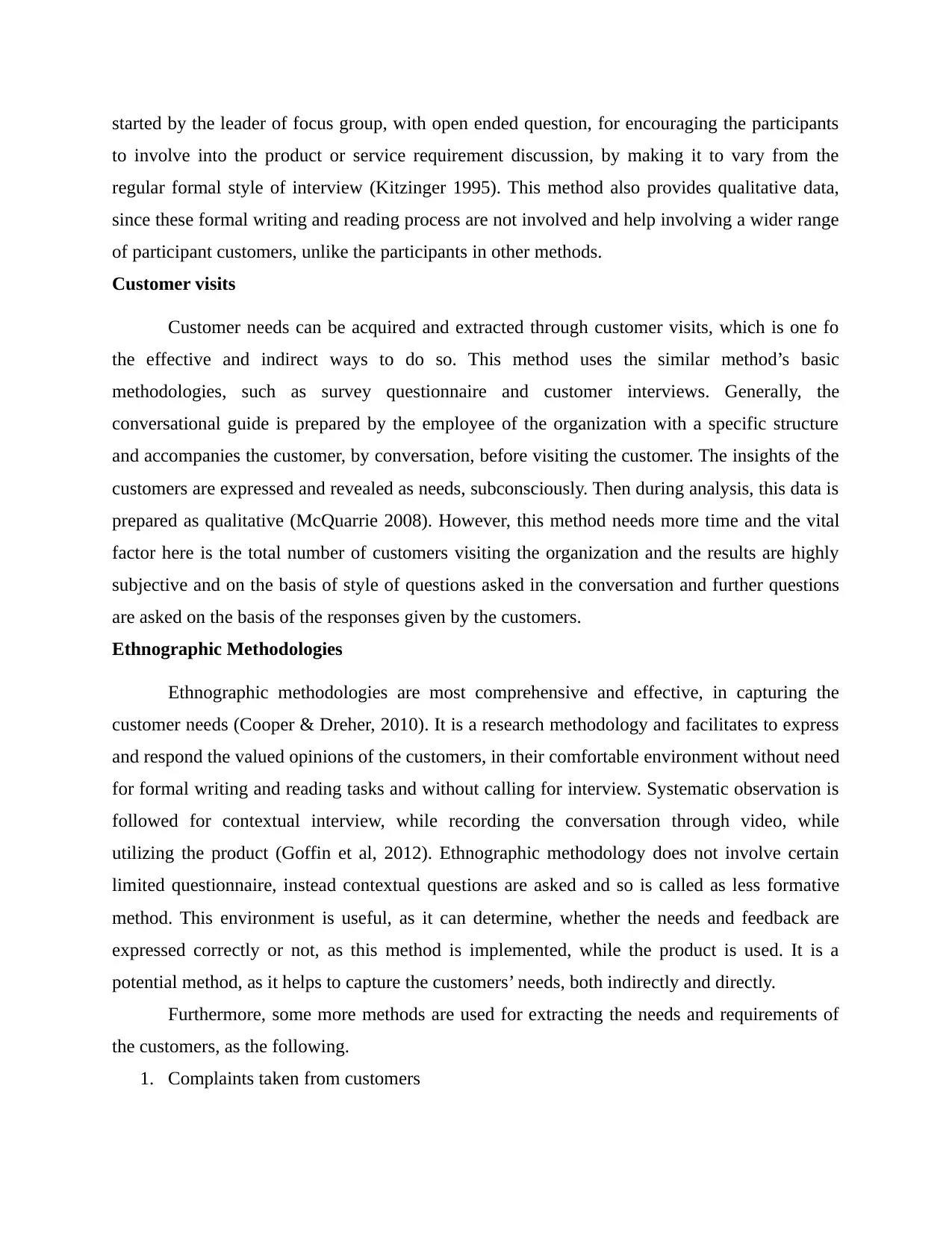
started by the leader of focus group, with open ended question, for encouraging the participants
to involve into the product or service requirement discussion, by making it to vary from the
regular formal style of interview (Kitzinger 1995). This method also provides qualitative data,
since these formal writing and reading process are not involved and help involving a wider range
of participant customers, unlike the participants in other methods.
Customer visits
Customer needs can be acquired and extracted through customer visits, which is one fo
the effective and indirect ways to do so. This method uses the similar method’s basic
methodologies, such as survey questionnaire and customer interviews. Generally, the
conversational guide is prepared by the employee of the organization with a specific structure
and accompanies the customer, by conversation, before visiting the customer. The insights of the
customers are expressed and revealed as needs, subconsciously. Then during analysis, this data is
prepared as qualitative (McQuarrie 2008). However, this method needs more time and the vital
factor here is the total number of customers visiting the organization and the results are highly
subjective and on the basis of style of questions asked in the conversation and further questions
are asked on the basis of the responses given by the customers.
Ethnographic Methodologies
Ethnographic methodologies are most comprehensive and effective, in capturing the
customer needs (Cooper & Dreher, 2010). It is a research methodology and facilitates to express
and respond the valued opinions of the customers, in their comfortable environment without need
for formal writing and reading tasks and without calling for interview. Systematic observation is
followed for contextual interview, while recording the conversation through video, while
utilizing the product (Goffin et al, 2012). Ethnographic methodology does not involve certain
limited questionnaire, instead contextual questions are asked and so is called as less formative
method. This environment is useful, as it can determine, whether the needs and feedback are
expressed correctly or not, as this method is implemented, while the product is used. It is a
potential method, as it helps to capture the customers’ needs, both indirectly and directly.
Furthermore, some more methods are used for extracting the needs and requirements of
the customers, as the following.
1. Complaints taken from customers
to involve into the product or service requirement discussion, by making it to vary from the
regular formal style of interview (Kitzinger 1995). This method also provides qualitative data,
since these formal writing and reading process are not involved and help involving a wider range
of participant customers, unlike the participants in other methods.
Customer visits
Customer needs can be acquired and extracted through customer visits, which is one fo
the effective and indirect ways to do so. This method uses the similar method’s basic
methodologies, such as survey questionnaire and customer interviews. Generally, the
conversational guide is prepared by the employee of the organization with a specific structure
and accompanies the customer, by conversation, before visiting the customer. The insights of the
customers are expressed and revealed as needs, subconsciously. Then during analysis, this data is
prepared as qualitative (McQuarrie 2008). However, this method needs more time and the vital
factor here is the total number of customers visiting the organization and the results are highly
subjective and on the basis of style of questions asked in the conversation and further questions
are asked on the basis of the responses given by the customers.
Ethnographic Methodologies
Ethnographic methodologies are most comprehensive and effective, in capturing the
customer needs (Cooper & Dreher, 2010). It is a research methodology and facilitates to express
and respond the valued opinions of the customers, in their comfortable environment without need
for formal writing and reading tasks and without calling for interview. Systematic observation is
followed for contextual interview, while recording the conversation through video, while
utilizing the product (Goffin et al, 2012). Ethnographic methodology does not involve certain
limited questionnaire, instead contextual questions are asked and so is called as less formative
method. This environment is useful, as it can determine, whether the needs and feedback are
expressed correctly or not, as this method is implemented, while the product is used. It is a
potential method, as it helps to capture the customers’ needs, both indirectly and directly.
Furthermore, some more methods are used for extracting the needs and requirements of
the customers, as the following.
1. Complaints taken from customers
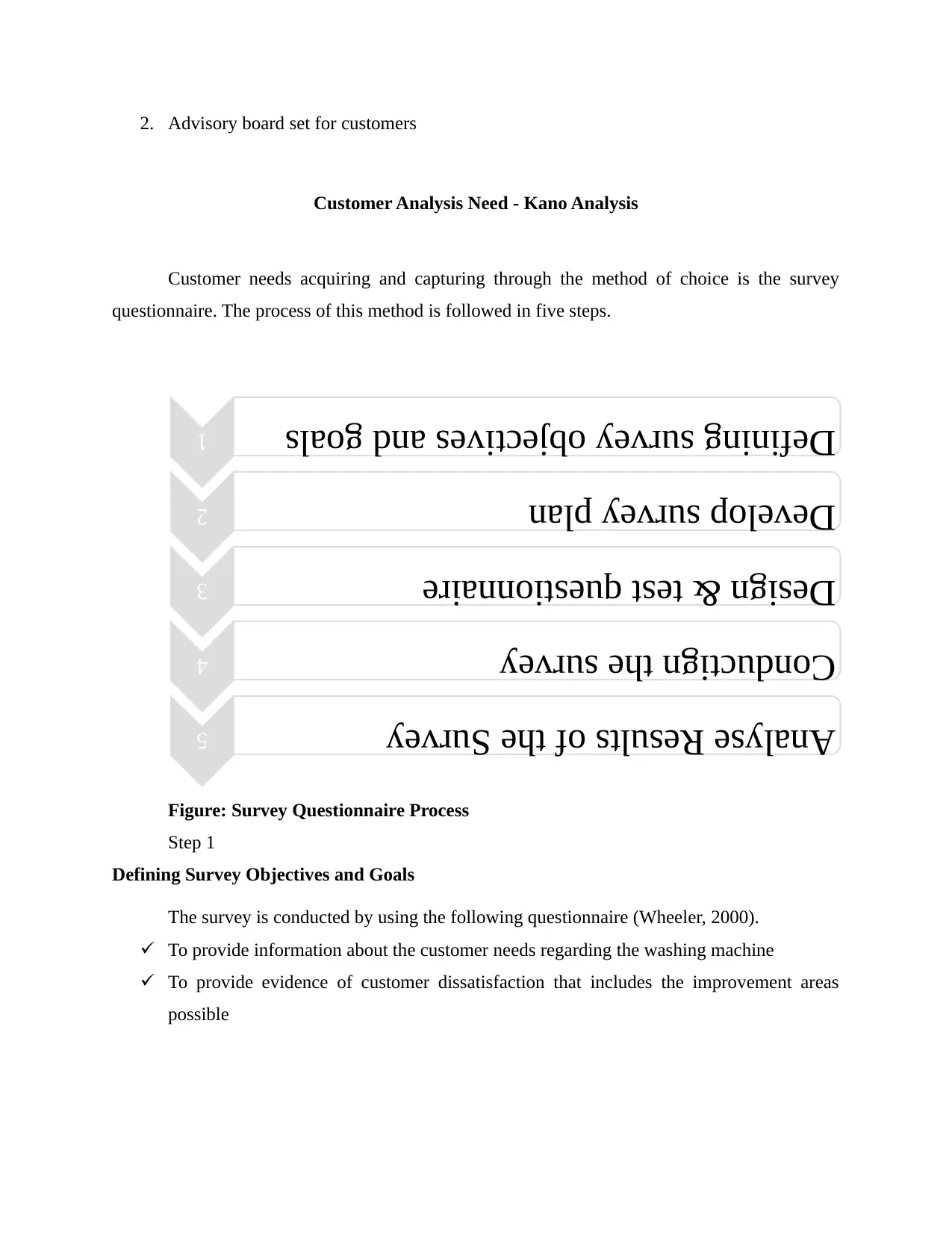
2. Advisory board set for customers
Customer Analysis Need - Kano Analysis
Customer needs acquiring and capturing through the method of choice is the survey
questionnaire. The process of this method is followed in five steps.
Figure: Survey Questionnaire Process
Step 1
Defining Survey Objectives and Goals
The survey is conducted by using the following questionnaire (Wheeler, 2000).
To provide information about the customer needs regarding the washing machine
To provide evidence of customer dissatisfaction that includes the improvement areas
possible
1Defining survey objectives and goals
2Develop survey plan
3Design & test questionnaire
4Conductign the survey
5Analyse Results of the Survey
Customer Analysis Need - Kano Analysis
Customer needs acquiring and capturing through the method of choice is the survey
questionnaire. The process of this method is followed in five steps.
Figure: Survey Questionnaire Process
Step 1
Defining Survey Objectives and Goals
The survey is conducted by using the following questionnaire (Wheeler, 2000).
To provide information about the customer needs regarding the washing machine
To provide evidence of customer dissatisfaction that includes the improvement areas
possible
1Defining survey objectives and goals
2Develop survey plan
3Design & test questionnaire
4Conductign the survey
5Analyse Results of the Survey
⊘ This is a preview!⊘
Do you want full access?
Subscribe today to unlock all pages.

Trusted by 1+ million students worldwide
1 out of 37
Related Documents
Your All-in-One AI-Powered Toolkit for Academic Success.
+13062052269
info@desklib.com
Available 24*7 on WhatsApp / Email
![[object Object]](/_next/static/media/star-bottom.7253800d.svg)
Unlock your academic potential
Copyright © 2020–2025 A2Z Services. All Rights Reserved. Developed and managed by ZUCOL.





